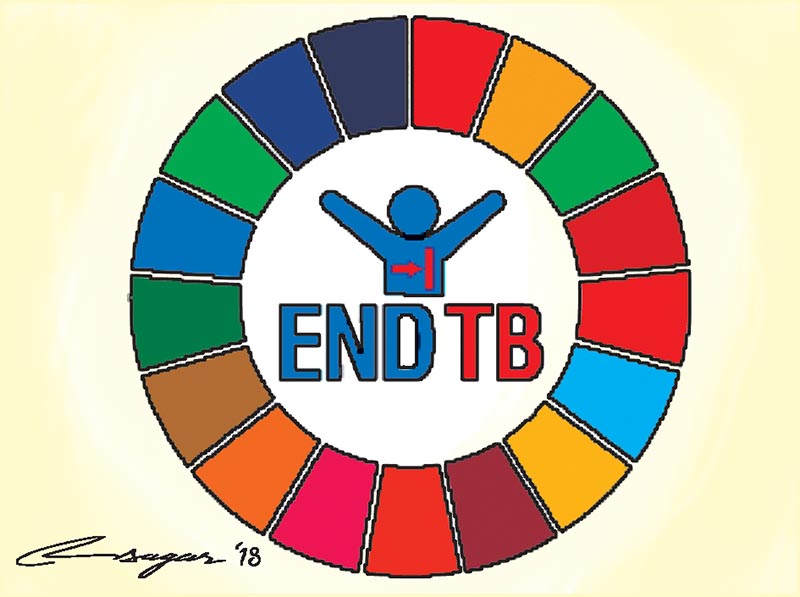Standing tall: Fighting TB & NCDs
The WHO South-East Asia Region accounts for 50 per cent of TB-associated mortality, with TB being the Region’s leading cause of death and lost productive years in the crucial 15-49 years old age group
On September 26-27, the world’s most esteemed political forum — the UN General Assembly (UNGA) — will deliberate on how best to address two equally challenging public health issues: tuberculosis (TB) and non-communicable diseases (NCDs).
For many years WHO South-East Asia and its Member States have been Ground Zero in the battle against both. The numbers show why: the Region accounts for 50 per cent of TB-associated mortality, with TB being the Region’s leading cause of death and lost productive years in the crucial 15-49 years old age group. TB/HIV co-infection is meanwhile responsible for 25 per cent of AIDS-related deaths. On NCDs, though the Region accounts for a bit over a quarter of the world’s population, it is home to around 29 per cent of NCD-related premature mortality. Every year 8.9 million people in the Region die of NCDs, accounting for 64 per cent of all deaths, many of which are entirely preventable.
The adverse impact these problems have on health and development — and in the case of TB, on health security — cannot continue. Not for the Region’s 1.8 billion people, who have a right to the highest attainable standard of health; nor for the pursuit of the Region’s Flagship Priorities and the Sustainable Development Goal targets.
To their immense credit, Member States are making strong gains.
In recent years each one of them has pledged unprecedented political commitment to tackle TB, as expressed in the 2017 “Delhi Call for Action” and the 2018 “Statement of Action” — a bold and very public vow to accelerate sustainable progress to End TB by 2030. That commitment continues to be reflected in on-the-ground action, including initiatives aimed at scaling up active case-finding, increasing nutritional assistance for TB sufferers, addressing latent TB and enhancing investments in research and development among other priorities.
Political resolve to tackle NCDs has likewise been robust. As per the Colombo Declaration, which Member States adopted in 2016, each of them is committed to integrating NCD services at the primary level, while country-specific multi-sectoral action plans to counter the problem have been developed and rolled out Region-wide. These have included a range of groundbreaking initiatives, from nutrient labelling systems that enhance health literacy to promoting physical activity through the provision of outdoor gyms.
The forthcoming High-Level meetings at UN headquarters in New York provide the Region significant scope to consolidate these many gains, accelerate progress, and promote game-changing innovations in each of these areas.
How so?
Start with TB. The High-Level meeting provides Member States an open — and global — platform to highlight the problem’s significance and present a detailed outline of how they are addressing it. Of note is the chance to underscore the dramatic increase high-burden countries have made in domestic funding and the accelerated progress adequate resources from the global community could generate. While the meeting will emphasise the need to pursue differentiated strategies according to a country’s TB burden, of critical importance to all — whether high-burden, medium-burden or low-burden — is harnessing greater investment in research and development, at the same time as influencing and participating in developing low-cost, affordable diagnostics and drugs to treat the disease.
For NCDs, the stakes are similarly high. The meeting provides Member States the opportunity to highlight progress since the first High-Level UNGA meeting was held in 2011, as well as reiterate political momentum and resolve as they reach the half-way mark in the quest to reduce premature deaths caused by NCDs by a quarter by 2025. Importantly, it will also provide an opportunity to highlight where more spending is needed and how governments can be better supported in implementing their country-specific plans. That includes by emphasising the significance of preventive measures that are among the most cost-effective (though underfunded) ways to deal with the problem.
Member States Region-wide are well prepared. In recent months WHO South-East Asia has worked to support them on technical and procedural matters associated with the meetings, and to secure several speaking roles — as well as positions on stakeholder panels — that are crucial to amplifying the Region’s voice. That support is part of WHO South-East Asia’s ongoing effort to work with Member States to develop regional positions on specific issues where feasible, and to ensure each country’s voice is fully leveraged.
Given the opportunities at hand, that outcome is vital. Even as Member States Region-wide make strong domestic inroads in tackling TB and NCDs, gains must be consolidated, sustainable progress accelerated, and innovation promoted and pursued as a matter of priority. Each of the UNGA’s High-Level meetings provides the opportunity to make that happen. Now more than ever, by standing tall, highlighting progress and effectively communicating their interests, Member States can return from the meetings having secured the support needed to drive lasting progress. In the battle against both TB and NCDs, who dares will indeed win.
Singh is regional director, World Health Organisation, South-East Asia






